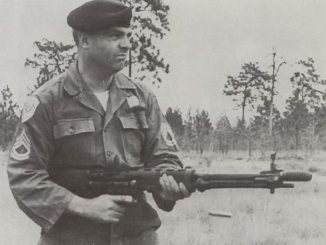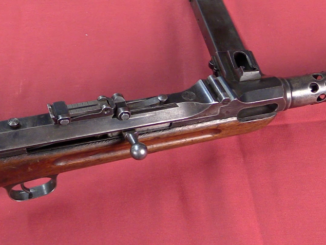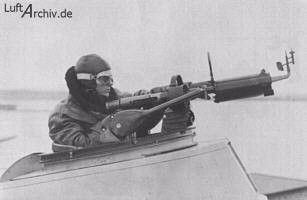This rifle sold for $10,925 at Rock Island on December 2, 2018.
While Karel Krnka and Georg Roth were in the process of developing the M1907 pistol, they diverted slightly to apply their patents to a fancy sporting semiauto rifle – the Model 1899. Produced and marketed by Haenel, the 1899 was a long recoil, rotating bolt design chambered for the German 8x45mm cartridge (approximately a 150 grain bullet at 1800 fps). The rifle was very expensive, selling for $150 around 1900-1905, ad this was probably the largest single reason why it failed to be commercial successful. At the same time, a very nice bolt action sporting rifle could be bought for $40-$50, and a brand new Winchester 1897 shotgun for $27. There is a question of whether the 1899 was the first commercial sporting semiauto rifle available, and unfortunately I don’t have the data to conclusively say. The patent dates are 1899, but that does not mean it was actually in production in 1899. It was certainly contemporary to the earliest Remington and Winchester offerings, but was not necessarily the first among them.




“8x45mm cartridge (approximately a 150 grain bullet at 1800 fps)”
Query in municion: http://municion.org/Krnka/8_2Krnka.htm
notice it modern look, remembering it is 19th century design.
“approximately a 150 grain bullet at 1800 fps”
This makes it roughly equivalent to .35 Winchester Self-Loading which throws 180 grain bullet at 1396 ft/s. Long-recoil operation looks to be overkill there.
“rifle was very expensive, selling for $150 around 1900-1905”
What about price of ammunition?
“patent”
Excerpt from relevant patent might be found here, 2nd image from bottom:
http://www.littlegun.info/arme%20autrichienne/ancien%20artisan/a%20krnka%20karel%20gb.htm
Notice that its title contain Feuerwaffe which does not imply whatever if it is short (automatic pistol) or long (rifle/shotgun) arm, even if drawing is suggesting first option.
AT3254 shows both pistol and rifle, no idea why the rifle is omitted from the German patent.
And the standard rifle and its predecessor (forgot the name) close to that but small firm and litle success
Meant for one narrow application- if you were a battue shooter in 1899, this was a significant advantage over everything else. And it would be a perfectly good rifle for that today.
That 8×45 cartridge sounds interesting. Sounds like it might fit an AR magazine.
It sounds dimensionally similar to the Czech 7.62 x 45mm round for the Vz52 carbine;
https://en.wikipedia.org/wiki/7.62%C3%9745mm
Standard for that one was a 131 gr. FMJ @ 2,500 F/s for 1,800 FPE. Or with about 80% greater muzzle energy that the Haenel round.
cheers
eon
Right, this comparison invites itself. But there are some 50plus years of development in the meantime.
Still, I would call these ballistic sedate for its size, even by 1890s standards. Let’s take for comparison 9,1×40 R Tesching cartridge:
https://naboje.org/node/3089
Description: Sporting-hunting cartridge from 1890s. Popularity peak before Great War. Initially black-powder loaded, later smokeless. There existed also version loaded with shot. Muzzle velocity was 545 m/s for 9,00 g heavy bullet.
This is in imperial style: 139.5 grains at 1788 fps.
Bit less (around 92% – both in terms of momentum and energy), but notice that 9,1×40 R is just smaller and was originally conceived as black-powder cartridge, so smokeless variants have to be limited to not destroy existing weapons.
Sadly, length of test barrel is not given for 9,1×40 R cartridge.
“Sounds like it might fit an AR magazine.”
In terms of diameter there should be not issue as much “fatter” cartridge were proven to, for example .458 SOCOM. So question is if it would fit length-wise, municion states 57,15 mm overall length for 5,56×45 NATO and 60,15 mm for Krnka, so I think it might be possible magazines in which would it fit, but it can not be taken for granted.
Boy, that is a real beauty of a gun! Too bad it was hampered by production costs. If there was a way to simplify construction/processing without compromising performance and structural integrity, would this have been a success?
Not really. The problem with long-recoil designs is that they have to be machined to very tight tolerances to actually work. Even then, they often require options like lubricated cartridges due to their generally poor primary extraction.
The Chauchat LMG is a case in point. A long-recoil action, it didn’t work mainly because there was no way to make it reliable within the tolerances the bicycle-factory level of production it was made by could achieve at the time (1916).
I suppose modern techniques like investment casting, metal sintering, and even 3d printing could cut costs, but you’d still end up with a mechanism that’s more complex than it needs to be for the job.
There are several reasons long recoil has been pretty much completely supplanted by short-recoil, gas operation, and even blowback, and this is the single biggest one.
cheers
eon
At least the Chauchat was cheap and easy to build in bulk compared to most other designs. I guess the only way to make the Roth-Haenel rifle successful is to change the method of cycling to a short-recoil design. But that’s purely academic now.
“There are several reasons long recoil has been pretty much completely supplanted by short-recoil, gas operation, and even blowback, and this is the single biggest one.”
I want to add that one of advantages of long recoil operation is softening felt recoil.
While it certainly apply to every size of cartridge, that one which was used with 150 grains at 1800 fps, already itself was so mild that it did not require such complicated system. Notice that in term of momentum (=270000) it is below .44-40 Winchester loading from early 20th century which drive 200 grain at 1540 fps (from 24″ barrel) giving 308000 momentum (which mean for single-shot weapons of equal masses and ergonomics and exactly effective muzzle brakes Krnka cartridge would “kick shooter less” than .44-40)
Softening felt recoil? Not really. Look at Hungarian .50cal Gepard. It kicks like any other. Without that massive muzzle-break it would be unbearable.
https://www.youtube.com/watch?v=5KScIfxaKMM
Whole point is missing if you do not take time into consideration. Notice that Chauchaut fires slowly at 240 rpm. Recoil softening is mostly visible in full auto weapons, but to lesser degree it can be found in self-loaders.
Please consider this footage: https://www.youtube.com/watch?v=NBntnnCFvOk
Assuming that normal (not reduced charge) cartridges are used it shows ability to fire GM-6 off-hand, so felt recoil seems to be low for 12,7×99 NATO cartridge. For comparison notice that OSV-96 is designed solely to be fired from bi-pod (no front furniture), though to be honest it fire more powerful 12,7×108 cartridge.
Long-recoil operation is one of options if you intentionally want to have low Rate-of-Fire, which seems to be one of reason of choice of long recoil operation by designers of LAG 40 SB-M1 according to:
http://zonwar.ru/granatomet/stankovie/LAG-40.html
it fire 215 rpm, for comparison Mk.19 – 300…400 rpm
The most successful full power semiauto long guns before 1930, I’d argue the only truly successful and truly full power semiauto long guns before the 1930s, were both long recoil Browning designs. Late 19th century factories were perfectly capable of producing reliably tens of thousands of these designs at commercially competitive prices.
Nice piece of work by K.Krnka. It appears that at the end of 19.century and start of 20th the long recoil was favored way how to introduce semi-auto cycle into rifles (Remington 8 comes immediately to attention). It was time of exploratory work and the long recoil disappeared soon afterwards.
“end of 19.century and start of 20th the long recoil was favored way how to introduce semi-auto cycle into rifles”
I can’t agree. While it appeared it is hard to call it dominating.
Meunier ended with long-recoil operation, but initially used gas operation.
Farquhar and Hill started with long-recoil operation, but ended with gas operation.
Móndragon was gas-operated.
Madsen (which was rifle before evolved into light machine gun, see photo: http://modernfirearms.net/en/military-rifles/self-loading-rifles/denmark-self-loading-rifles/madsen-m1896-eng/ ) was short recoil operated
Cei-Rigotti was gas operated
Sjögren (both shotgun and rifle) used inertia
and so on
“long recoil disappeared soon afterwards.”
It looks that Karel Krnka also abandon this system. See 3 weapons in VHU PRAHA collection:
Puška ZB-Krnka 1925 (Rifle ZB-Krnka 1925)
http://www.vhu.cz/exhibit/puska-zb-krnka-1925/
If I understand correctly it was short-recoil/tilt (in original: Systém s krátkým zpětným pohybem hlavně a závěrem uzamčeným pomocí otočné objímky našroubované na zadním konci hlavně nepředstavoval z hlediska armádního použití příliš vhodnou konstrukci.)
Automatická puška („samostříl“) Krnka, výrobní číslo 2 (I do not know what samostříl means in Czech language, anyway it is samostříl number 2)
http://www.vhu.cz/exhibit/automaticka-puska-samostril-krnka-vyrobni-cislo-2/
Which (again if I understand correctly) was short-recoil/tilt (in original: Oba Krnkovy samostříly fungovaly na principu uzamčeného závěru s krátkým zpětným pohybem hlavně, přičemž na hlavni měl našroubováno uzamykací pouzdro, opatřené na obvodu dvěma protilehlými řídícími ozuby.)
Automatická puška („samostříl“) Krnka, výrobní číslo 3 (samostříl number 3)
http://www.vhu.cz/exhibit/automaticka-puska-samostril-krnka-vyrobni-cislo-3/
If I understand correctly enough again it is short-recoil/tilt (in original: samostříl fungoval na principu uzamčeného závěru s krátkým zpětným pohybem hlavně, přičemž na hlavni měl našroubováno uzamykací pouzdro, opatřené na obvodu dvěma protilehlými řídícími ozuby. V dutině pouzdra byly vyfrézovány dvě uzamykací drážky, do nichž se uzamykala dvojice symetrických uzamykacích ozubů v přední části závěru. Samotný závěr tak vykonával pouze axiální pohyb. Ovládací prvky tvořily dva válcové hmatníky na horní ploše závěru. Hlaveň byla uložena v ocelovém plášti s otvory pro odvod tepla a uzamykací spojku odpružovala samostatná pružina, uložená ve spodní části.)
All of these weapons used 7,9×57 Mause cartridge and all were quite heavy weighting respectively 5640 g (with empty 10 round magazine), 7680 g [weapon only?] and 6410 g (with empty 10 round magazine)
“I do not know what samostříl means ….”
It is equivalent of medieval crossbow; arbolet in Russian.
After birth of country and start of development of its armament industry, Czechs did not have now common terminology for some products. You can consider this term to be same as Samopal or Avtomat. Same thing.
Another term which comes to mind is “utocna vozba” (diacritics missing). Sounds like complete non-sense in current terms. In fact it refers to mechanized units.
Interestingly, talented Krnka did not have life in rosegarden after return to his homeland:
(citation)
Konstruktér Karel Krnka (1858–1926) žil od roku 1898 v Rakousku, teprve v roce 1922, kdy mu končila pracovní smlouva s továrnou v Hirtenbergu, se obrátil na vlivné činitele v republice s nabídkou svých konstrukcí a uplatnění v některém ze zbrojních závodů. Jednání Čs. státní zbrojovky v Brně ohledně konstruktérova zaměstnání, vedené z podnětu MNO, ztroskotala na Krnkových nárocích. Uplatnění našel v pražské Zbrojovce Praga ve Vršovicích, jež upravila pro zkoušky nejen dovezený exemplář Krnkovy automatické pušky, ale také se zavázala vyrobit jeden zcela nový.
(translation)
Designer K. Krnka lived since 1898 in Austria and only after his contract with Hirtenberg factory ended in 1922, he turned to officials of influence at home to facilitate for him application in one of Czech arms making factories.
However, mediated negotiations with Cs. state armament factory in Brno ended with disagreement over Krnka’s demands. Eventually armament factory Praga offered him job and adopted one of Krnka’s imported semi-automatic rifle and agreed to build another brans new one (for state trials).
____
So, as we see from this, the designer did not receive “hero’s welcome”. Neither was his design implemented to military inventory. Kind of tough luck, one can say.
Excerpt from second article; regarding short recoil operated rifle:
(citation)
Mittelhauserovy podmínky kladené na samostříl (automatickou pušku) vyprofilovalo MNO počátkem roku 1923, kdy obesílalo domácí a zahraniční výrobce. Oproti francouzským náhledům již měl mít samostříl maximální hmotnost do 6,5 kg bez zásobníku, vzduchem chlazenou hlaveň, zásobování odnímatelným zásobníkem s minimální kapacitou 10 nábojů a možnost nošení na rameni stejně jako u opakovačky. Další specifikace se týkala teoretické rychlosti střelby či schopnosti vystřelit v samočinném režimu 100 ran, aniž by došlo k zádržce či poruše zbraně. Jednoznačně měla být zařízena na náboj 7,92 mm Mauser.
(translation)
Mittelhauser’s (chief of staff) requirements for semi-automatic rifle which MoD formulated into specification in 1923 and sent to domestic and foreign armament makers were as following.
In spite of French views, it called for weapon with max. weight of 6.5kg with empty magazine, air cooled. Removable magazine capacity was to be 10rds at minimum while shouldering and operation was to be similar as with bolt action rifle.
Next part of specification called for continuous firing of hundred shots without stoppage. Round to be used was selected as 8mm Mauser.
—–
Apparently, Krnka’s model rifle had difficulty with such requirements and eventually (trials were held along with two other prototypes) none was adopted. Curiously, the first generally adopted semi-auto rifle for Csl. military was vz.52.
The pivoting piece on the barrel extension looks like it could serve as an ejector as well as a trip for the bolt hold back device.
A properly sized fork mounted in a vice could be used to hold the barrel sleeve within the shroud allowing installation of the barrel nut without fighting spring tension. A simple edge could be used, but would require much more care.
It seems to me at this period of time that there was a certain paranoia about opening the breech in a hand or shoulder arm — the artillery of the day was long-recoil (for ejection, not reloading), well, so should small arms be! When J.M. Browning designed his long-recoil shotgun (1899 patent), he was anticipating a variety of loadings, including black powder, smokeless, and the different weights of shot and slug. Thus also the adjustable recoil brake under the barrel. In the meantime, he also designed and patented a long-recoil pistol! Only he and Mannlicher patented blowback designs, and Colt would not produce a blowback pistol until FN had made a success of the Modele 1900 — both in proven sales and proven safety.
Maxim having proven the safety of short recoil in a full-power rifle caliber in 1888, it took Borchardt, Luger, Browning, Mannlicher, Mauser (that is, the Federle Bros. in his employ) and Bergmann (i.e. Schmeisser) a few years to scale the idea down to pistols. These designers were all dependent on the progress of cartridge design, both smokeless powder and consistent headspacing in manufacture, and thus that bandwagon got rolling.
Therefore both short recoil and gas operation for small arms really wasn’t universally trusted until proven in World War I.
I note that this bolt return/striker has a bit in common with the Maxim-Silverman and Schwartzlose pistols, and my question is: If the bolt is shoved back to battery by the striker moving forward, is it only inertial movement that turns and locks the bolt before the trigger is pulled? This seems less than positive — if the bolt does not go fully home, the striker must lock the bolt on the way to discharging the cartridge. I think this would increase lock time and perhaps degrade accuracy, and perhaps subtract some kinetic energy that should hit the primer cap, resulting in possible misfires.
Not a problem in the Browning guns, which were hammer-fired under separate spring tension. In the A5 shotgun locking was incredibly positive since the recoil spring tensioned on the actual locking lug, insuring a fully locked breech before the trigger was pulled. Any speculation here would be welcome.
“(…)gas operation for small arms really wasn’t universally trusted until proven in World War I.(…)”
I am not sure about that – Hotchkiss machine gun was quite successful.
According to https://en.wikipedia.org/wiki/Hotchkiss_M1914_machine_gun
In 1898 an export model was offered for international sales by Hotchkiss and sold to Brazil, Chile, Japan, Mexico, Norway and Venezuela that year.
“Schwartzlose”
Schwarzlose (unless there is pun intended, which I do not understand)
Sorry, spelled Schwarzlose’s name in phonetic English … Z in German is “tz” in my native tongue …
An interesting comment. Ian seems to say that the firing pin does not move forward to the sear until the bolt is locked. With the camming lugs so far forward on the firing pin, the locking lugs rotate with over a thumb width of travel before the firing pin protrudes out of the bolt face. YMMV
Meant as a reply to LDC.
Dear bp: If you are saying the bolt is locked and no longer rotating by the time the firing pin reaches the sear, with reserve power in the spring to discharge the primer, then I am guilty of poor observation. Makes perfect sense, and also a fine out-of-battery safety. Thanks for pointing this out.
$150 in 1900 = around $4000 in current money.
You can see photo of Karel Krnka here (1st from top):
http://www.vhu.cz/exhibit/pokusna-samonabijeci-puska-krnka-hirtenberg/
Interesting article. It says that Krnka’s prototype he brought with him to his homeland was chambered in 7mm Krnka experimental cartridge. That was undoubtedly a visionary endeavour.
It also states that after his inroads at Zbrojovka Praga he eventually started to work with Zbrojovka Brno where he participated on design of light machinegun. So, his fingerprints must have been on vz.24/26 LMG.
Krnka published a book on the principles of firearms mechanisms under the pseudonym of “Kaisertreu” (meaning loyal to the Austrian emperor). Basically, it is full of statements how brilliantly the long recoil Roth weapons (his creations) and how incompetently the Mannlicher mechanisms are designed.
I am not surprised that the Czechs and Slovaks did not receive him with open arms.
““Kaisertreu” ”
Enlightenment!
Fyodorov mentions “Kaisertreu classifications of weapons operation principle” and state it was first one published, but I do not know that Kaisertreu and Karel Krnka was same entity.
Interesting: want to diss Mannlicher, publish first classification for [self-loading] weapons.
Similar bolt to an FG42
I need some very specific info. What was the very first automatic rifle of German origin? I have found some very obscure information on a rifle made by Mauser dating back to 1898, but I don’t know if it was the very first. Could you help me?